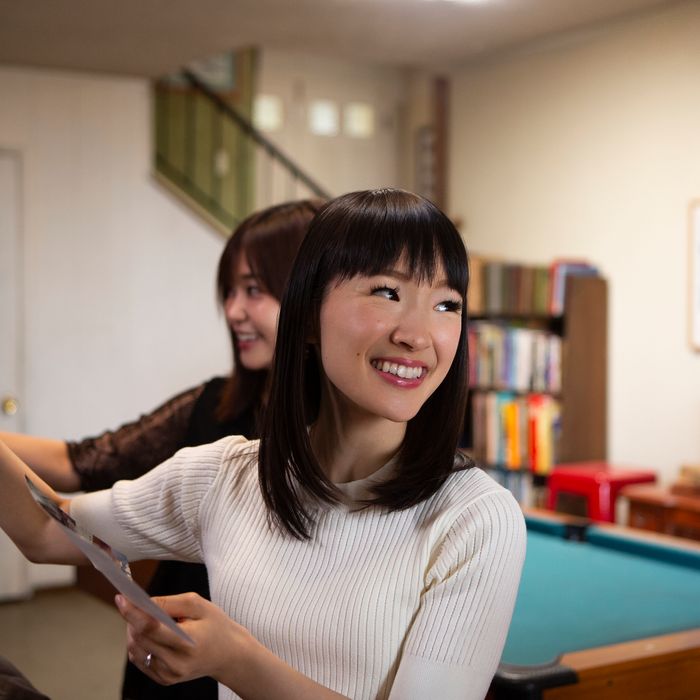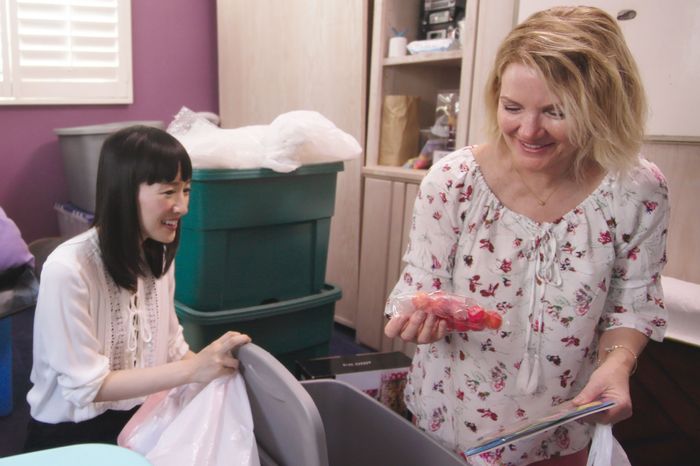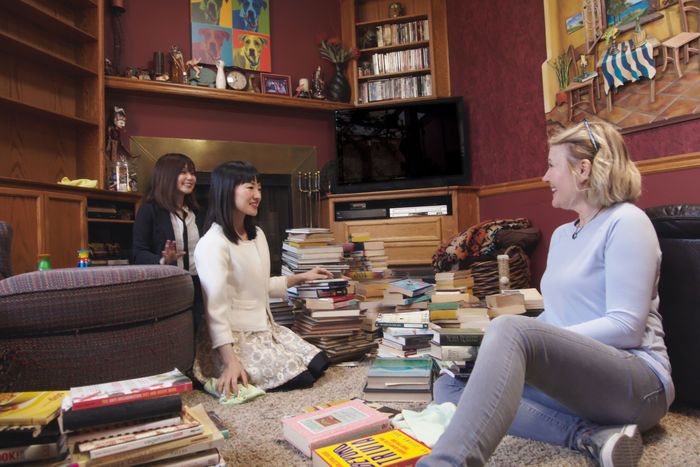
It’s a sunny afternoon in mid-May, and Japanese author Marie Kondo is helping Margie, a recently widowed 59-year-old woman with whom she’s been working since March. Margie has lived in her two-story Culver City house for 29 years. Her three grown children have moved out (but left lots of belongings behind), and she recently lost her husband, Rick, to colon cancer. They ran a restaurant together called Tub’s Fine Chili, and the décor embraces their flair for kitsch: A neon Rick’s Café sign hangs over the bar, and there’s a wooden carousel horse on a brass pole in the bay window.
Despite having spent an inordinate amount of time among the viscera of other people’s homes, surveying their dust-covered possessions and everyday messes, Kondo does not blend easily into her surroundings. In person, she is petite and immaculate, dressed in an ivory silk blouse and a pink floral skirt. If, for some reason, she were to do a cartwheel, I imagine every hair on her head would instantaneously return to its place in her neat, shoulder-length coif.
“I was quite apprehensive at first because I have a lot of stuff that is a little quirky and different from what I perceive is her minimalist style,” Margie tells me. “But Marie immediately said she could see how I am experiencing joy in my belongings. That made me feel very validated.”
At 34, Kondo is the only living person who can claim with any authority to be a “decluttering guru,” and for the past decade, she’s been on a mission to organize the world. Her books have sold 11 million copies in more than 40 countries, and on January 1, her Netflix series, Tidying Up With Marie Kondo, featuring Margie and seven other L.A.-area households, will bring Kondo’s philosophy and technique to a global audience.
For anyone unfamiliar with her KonMari method, here’s what you need to know: Most of us have way, way too much stuff. A lot of it does not “spark joy,” a phrase Kondo popularized, designed to help us evaluate what we actively want to keep as opposed to what we’re merely unwilling to throw away. Clothing, memorabilia, old laptops, greeting cards, and unused skin-care samples, for example, that do not spark joy when held in one’s hands should be thanked for their service and discarded. Everything else needs a proper place. This is all thoroughly and rather delightfully outlined in her books, The Life-Changing Magic of Tidying Up and its illustrated companion Spark Joy, both of which are so pert and unobtrusively sized that they appear to be making a case for their own necessity. It’s an enlightening process, but Kondo admits the approach took some finessing: Early on she held up a perfectly good hammer, found it joyless, trashed it, and then burst into tears when she broke her favorite ruler while trying to use it as a substitute tool.
The Netflix series, which will further the streaming giant’s move into the unscripted HGTV space, takes Kondo into the homes of clients at a crossroads: a Pakistani mother of two who can’t part with any of her children’s toys in the event that she has another baby; a newly transplanted Detroit family trying to fit everything from their spacious former house into a two-bedroom apartment; a young couple trying to establish their adulthood, mostly via furniture that’s been rescued from the street; a Japanese-American family with too many Christmas decorations. “In Japan, we put up Christmas decorations, but never to this extent,” says Kondo, frowning.
Margie, a bubbly, blonde California native who bears a passing resemblance to Kirsten Dunst, is Kondo’s final subject for season one of the series. It’s the last week of filming, and today, they’re focusing on file folders and boxes of papers, which typically constitutes the third organizing category. The process goes like this: clothes, books, documents, komono (miscellany), and, finally, sentimental items.
Kondo begins opening envelopes and making piles with the dexterity of a court stenographer. Her vibe is calm, almost ethereal; perhaps because she speaks via her interpreter, Marie lida, it’s as if she’s guiding the process spiritually, through a medium. That is, until she screams. A silverfish has scurried out from one of the boxes. “Don’t let him get away,” Margie says, though when Kondo shows no sign of intervening, she swiftly squishes him with her foot. I ask Kondo later if she gets used to these types of surprises in her line of work.
“It does happen, and I’m certainly not unfazed,” she says.
Margie finds an old L.A. Times story announcing Princess Diana’s death. Generally, Kondo doesn’t approve of saving magazines or newspapers, primarily if the intent is to read the articles at some later date.
“I guess with the royal wedding this is relevant,” says Margie, referring to Prince Harry and Meghan Markle’s upcoming nuptials. She looks expectantly at Kondo, who nods, but reminds her that anything saved should be stored so that it is easily accessible. Next, they come across a commemorative moon-landing poster.
“Is this a memory for you?” Kondo asks.
“I mean, it’s part of history,” says Margie, uncertain.
Kondo prods her. “Do you think your kids will want it?”
Margie pauses and then shakes her head. “Thanks, astronauts,” she says, as it goes in the garbage.
Once, in high school, Kondo began tidying her bedroom and didn’t stop until, eventually, she passed out from exhaustion. “That was quite unhealthy,” she admits later, over lunch. “I was obsessive. But once my role shifted to communicating my method to a large number of people, I think I was able to take a more nuanced stance.” She founded her consulting business, KonMari, as a 19-year-old university student, and after several years, the long wait list for her services prompted her to write a book to share her technique with more people. The global success of The Life-Changing Magic of Tidying Up meant Kondo could barely walk down a Tokyo street without being recognized. In 2016, KonMari began training other professionals in her method; there are now more than 300 independent, certified consultants around the world. “I thought the demand for tidying was uniquely Japanese, but that was not the case,” she says. Her popularity, particularly in the States, recently led Kondo to relocate to San Francisco with her husband and two daughters.
Her career, like her method, seems astonishingly disciplined, although maybe not unexpected of someone who has a favorite ruler. But what about bad habits? She must have one? Kondo places her pointer finger on her chin and thinks. (In the absence of a shared language, she tends to be sweetly gesticulative.) “I don’t like wearing my house slippers for long, so I’ll take them off and then completely forget where I left them,” she offers.
After Kondo’s first book was published here in 2014, there was a brief backlash to the tidying craze as people, and women in particular, objected to being told yet another thing they could be doing better in addition to juice cleanses, meditation, SoulCycle, and so on. But Kondo doesn’t consider her method a fad, and this is where the TV series comes in. “People can visually comprehend the effect of tidying,” says Kondo. “It’s not about feeling shame for how you live. It’s about exploring what you need to live as happily as possible.”
Kondo says that American clients differ from her Japanese ones, whom she used to visit with regularly before she began writing books. “[Americans] are more likely to take large, drastic actions, and Japanese people often get so caught up in thinking about things that they get stuck,” she says. “But the difference between tidying in [the countries] is not so much the people but the size and design of the homes. Shoe storage is typically a big challenge in America!” For the series, Netflix whittled hundreds of applicants down to 45 families before settling on these eight clients from differing backgrounds who are confronting various organizing dilemmas. While the KonMari method became hugely popular in the U.S. a few years ago, none of the show’s subjects were necessarily Kondo superfans. In fact, they’re often people who might find her methods a little odd.
“Some people on the show questioned why they would thank an inanimate object for its service,” recalls Kondo. “This was a revelation. I know now that I must explain some aspects of my work more clearly.”
Back at the house, the camera crew heads upstairs to prep for the next scene. Margie grabs a glass of water from the kitchen, where, in preparation for Kondo’s first visit, she wrote on a chalkboard, You come into the world empty-handed and you leave empty-handed. She had been vaguely familiar with “kondo-ing,” as it’s sometimes referred to, but had never read any of the books. After two months, she thinks she’s getting the hang of it. “My kids call me a hoarder — I’m not,” she says. “Hoarders have goat trails because they intend to keep it that way. My big thing was, how do you honor and respect a life without getting rid of everything, or keeping everything?” Yes, she finds the act of thanking her stuff “a little funny,” but also helpful as a way of expressing gratitude toward her late husband. “‘Spark joy’ isn’t necessarily my phrase, but there’s other ways to describe it,” she says. “Does it make me happy or comfortable? What if Katrina rolled through? What would I truly miss? Stuff is so unimportant when you lose a life.”
I ask if the language barrier has been at all distancing or otherwise a hindrance. “After the first hour, we were fine,” says Margie. “She seemed comfortable; I was comfortable. I did have to stop and laugh at the way we’re smiling at each other over organizing. But how much can you actually grasp in those visits anyway? You have to stop and absorb and reflect afterward.” Showrunner Bianca Barnes-Williams (also of Netflix’s Girls Incarcerated) is on set today, and adds that Margie’s experience of speaking via a translator was similar to others. “It takes longer,” she says, “but the families say the longer they work with her, the more they understand what she’s saying.”
Kondo is in the bedroom tackling some of the more sentimental documents that belonged to Rick. Margie’s already sorted his clothes according to the KonMari method, which suggests heaping everything on the floor first. “That was really jolting,” Margie says, “seeing his life in chapters, from the tropical-shirt phase to the restaurant-plaid phase.”
Barnes-Williams watches from a monitor, and tells me the crew was impressed with how much Margie got rid of on her own. “This is not like Dr. Phil, where you have to do this or that,” she says. “Marie offered to help, but she said no.”
On the bureau rests a framed photo of the couple standing in front of a blender filled with a yellow-tinted cocktail. In two weeks, they would have been married 38 years.
“I don’t want to see his medical stuff anymore,” says Margie. “His passport? That’s good to keep for the kids.”
Margie’s last assignment before Kondo leaves will be the most challenging: going through decades of old photographs. Kondo has helped arrange them on the dining-room table chronologically.
“No more family dinners for a while,” Margie says, surveying their work, which covers every inch of available surface area. “I can see this taking months.”
Kondo holds up a photo of young Margie sporting a heavily sprayed nimbus of ’80s hair.
“That sparks confusion,” Margie says, laughing.
Kondo smiles: “You have to be pretty selective because you have so many photos.” Margie wants to wait until she has a glass of wine in her hand to confront this task. “Don’t force yourself to tidy,” says Kondo, gently. “It’s an experience in itself.”
An earlier version of this piece stated that Marie Kondo is 33. She is 34.



